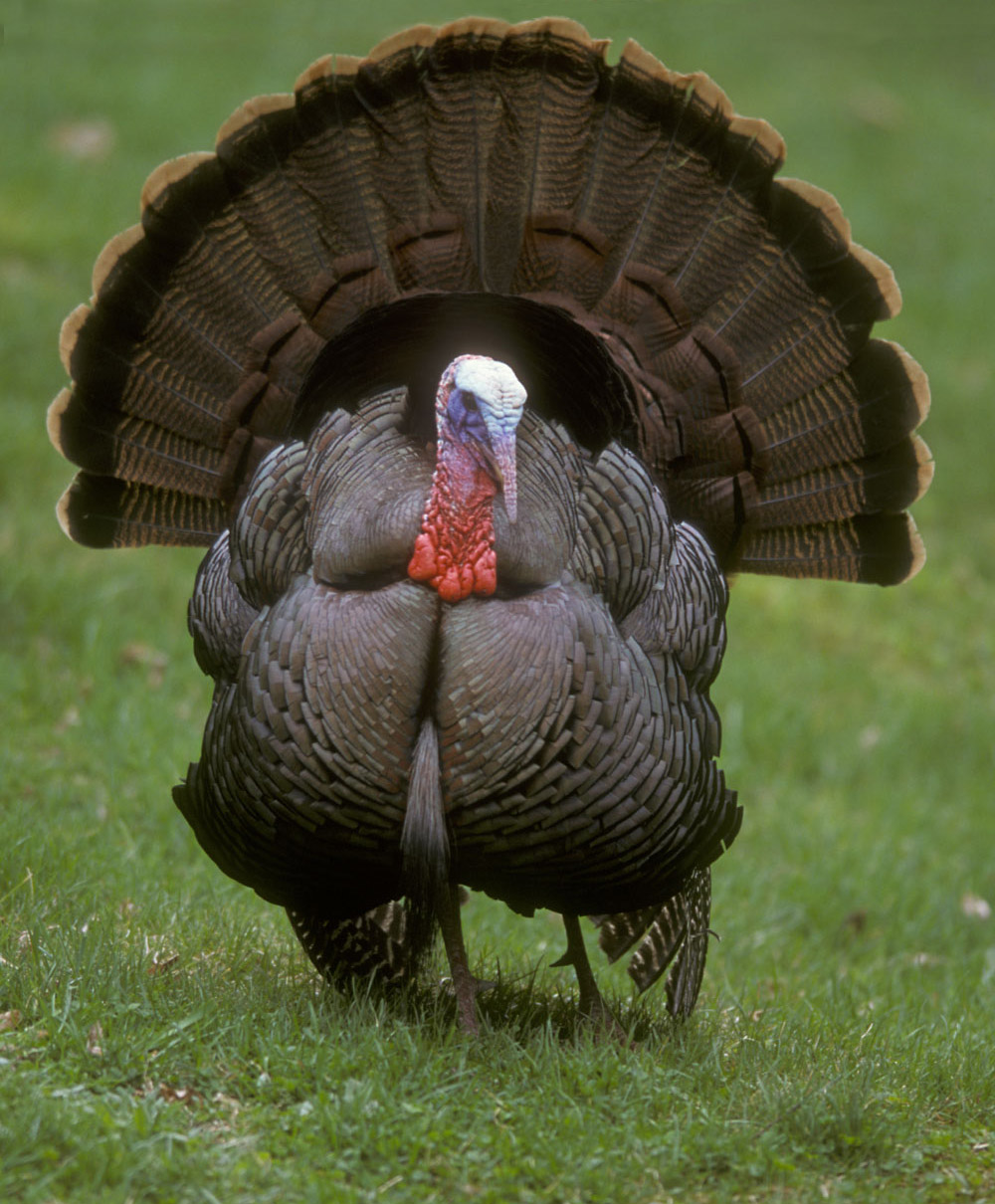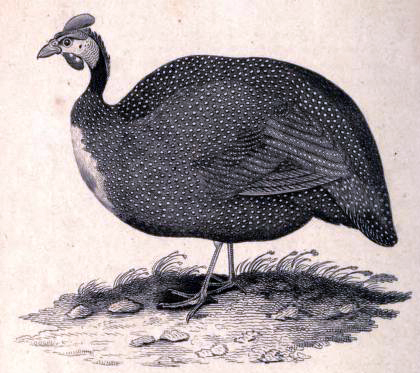|
Guineafowl
Guinea fowl () (or guineahen) are birds of the family Numididae in the order Galliformes. They are endemic to Africa and rank among the oldest of the gallinaceous birds. Phylogenetically, they branched off from the core Galliformes after the Cracidae (chachalacas, guans, and curassows) and before the Odontophoridae (New World quail). An Eocene fossil lineage '' Telecrex'' has been associated with guinea fowl; ''Telecrex'' inhabited Mongolia, and may have given rise to the oldest of the true phasianids, such as blood pheasants and eared pheasants, which evolved into high-altitude, montane-adapted species with the rise of the Tibetan Plateau. While modern guinea fowl species are endemic to Africa, the helmeted guinea fowl has been introduced as a domesticated bird widely elsewhere. Taxonomy and systematics This is a list of guinea fowl species, presented in taxonomic order. Phylogeny Cladogram based on a study by De Chen and collaborators published in 2021. Descrip ... [...More Info...] [...Related Items...] OR: [Wikipedia] [Google] [Baidu] |
Galliformes
Galliformes is an order (biology), order of heavy-bodied ground-feeding birds that includes turkey (bird), turkeys, chickens, Old World quail, quail, and other landfowl. Gallinaceous birds, as they are called, are important in their ecosystems as seed dispersers and predators, and are often reared by humans for their meat and eggs, or hunted as game birds. The order contains about 290 species, inhabiting every continent except Antarctica, and divided into five Family (biology), families: Phasianidae (including chicken, quail, partridges, pheasants, turkeys, peafowl (peacocks) and grouse), Odontophoridae (New World quail), Numididae (guinea fowl), Cracidae (including chachalacas and curassows), and Megapodiidae (incubator birds like malleefowl and Brushturkey, brush-turkeys). They adapt to most environments except for innermost deserts and perpetual ice. Many gallinaceous species are skilled runners and escape predators by running rather than flying. Males of most species a ... [...More Info...] [...Related Items...] OR: [Wikipedia] [Google] [Baidu] |
Helmeted Guinea Fowl
The helmeted guinea fowl (''Numida meleagris'') is the best known of the guinea fowl bird family, Numididae, and the only member of the genus ''Numida''. It is native to Africa, mainly south of the Sahara, and has been widely introduced, as a Domestic guinea fowl, domesticated species, into the West Indies, North America, Colombia, Brazil, Australia and Europe. Taxonomy The helmeted guinea fowl was Species description, formally described by Swedish naturalist Carl Linnaeus in 1758 in the 10th edition of Systema Naturae, tenth edition of his ''Systema Naturae'' under the binomial nomenclature, binomial name ''Phasianus meleagris''. In 1764, Linnaeus moved the helmeted guinea fowl to the new genus ''Numida''. The genus name ''Numida'' is Latin for "North African". In the early days of the European colonisation of North America, the native wild turkey (''Meleagris gallopavo'') was confused with this species. The word ''meleagris'', Greek language, Greek for guinea fowl, is als ... [...More Info...] [...Related Items...] OR: [Wikipedia] [Google] [Baidu] |
Numida
The helmeted guinea fowl (''Numida meleagris'') is the best known of the guinea fowl bird family, Numididae, and the only member of the genus ''Numida''. It is native to Africa, mainly south of the Sahara, and has been widely introduced, as a domesticated species, into the West Indies, North America, Colombia, Brazil, Australia and Europe. Taxonomy The helmeted guinea fowl was formally described by Swedish naturalist Carl Linnaeus in 1758 in the tenth edition of his ''Systema Naturae'' under the binomial name ''Phasianus meleagris''. In 1764, Linnaeus moved the helmeted guinea fowl to the new genus ''Numida''. The genus name ''Numida'' is Latin for "North African". In the early days of the European colonisation of North America, the native wild turkey (''Meleagris gallopavo'') was confused with this species. The word ''meleagris'', Greek for guinea fowl, is also shared in the scientific names of the two species, though for the guinea fowl it is the species name, whereas ... [...More Info...] [...Related Items...] OR: [Wikipedia] [Google] [Baidu] |
Helmeted Guinea Fowl
The helmeted guinea fowl (''Numida meleagris'') is the best known of the guinea fowl bird family, Numididae, and the only member of the genus ''Numida''. It is native to Africa, mainly south of the Sahara, and has been widely introduced, as a Domestic guinea fowl, domesticated species, into the West Indies, North America, Colombia, Brazil, Australia and Europe. Taxonomy The helmeted guinea fowl was Species description, formally described by Swedish naturalist Carl Linnaeus in 1758 in the 10th edition of Systema Naturae, tenth edition of his ''Systema Naturae'' under the binomial nomenclature, binomial name ''Phasianus meleagris''. In 1764, Linnaeus moved the helmeted guinea fowl to the new genus ''Numida''. The genus name ''Numida'' is Latin for "North African". In the early days of the European colonisation of North America, the native wild turkey (''Meleagris gallopavo'') was confused with this species. The word ''meleagris'', Greek language, Greek for guinea fowl, is als ... [...More Info...] [...Related Items...] OR: [Wikipedia] [Google] [Baidu] |
Numida Meleagris -Kruger National Park, South Africa-8a
The helmeted guinea fowl (''Numida meleagris'') is the best known of the guinea fowl bird family, Numididae, and the only member of the genus ''Numida''. It is native to Africa, mainly south of the Sahara, and has been widely introduced, as a domesticated species, into the West Indies, North America, Colombia, Brazil, Australia and Europe. Taxonomy The helmeted guinea fowl was formally described by Swedish naturalist Carl Linnaeus in 1758 in the tenth edition of his ''Systema Naturae'' under the binomial name ''Phasianus meleagris''. In 1764, Linnaeus moved the helmeted guinea fowl to the new genus ''Numida''. The genus name ''Numida'' is Latin for "North African". In the early days of the European colonisation of North America, the native wild turkey (''Meleagris gallopavo'') was confused with this species. The word ''meleagris'', Greek for guinea fowl, is also shared in the scientific names of the two species, though for the guinea fowl it is the species name, whereas ... [...More Info...] [...Related Items...] OR: [Wikipedia] [Google] [Baidu] |
Guttera
''Guttera'' is a genus of birds in the family Numididae. Established by Johann Georg Wagler in 1832, it contains four species: * Plumed guineafowl, ''Guttera plumifera'' * Eastern crested guineafowl, ''Guttera pucherani'' * Western crested guineafowl, ''Guttera verreauxi'' * Southern crested guineafowl, ''Guttera edouardi'' The name ''Guttera'' is a combination of the Latin words ''gutta'', meaning "spot" and ''-fera'', meaning "bearing" (from ''ferre'': to bear). The four species are found in forests of sub-Saharan Africa Sub-Saharan Africa is the area and regions of the continent of Africa that lie south of the Sahara. These include Central Africa, East Africa, Southern Africa, and West Africa. Geopolitically, in addition to the list of sovereign states and .... Unlike other guineafowl, they have a distinctive black crest. References {{Taxonbar, from=Q1028983 Bird genera ... [...More Info...] [...Related Items...] OR: [Wikipedia] [Google] [Baidu] |
Agelastes
''Agelastes'' is a small genus of birds in the guineafowl family. It comprises two species: * White-breasted guineafowl, ''A. meleagrides'' * Black guineafowl The black guinea fowl (''Agelastes niger'') is a terrestrial bird of the Numididae (guinea fowl) family found in humid forests in West-Central Africa. It is a medium-sized, black galliforme bird with a bare, orange-pink head and upper neck. As ..., ''A. niger'' References {{Taxonbar, from=Q515968 Bird genera Taxa named by Charles Lucien Bonaparte ... [...More Info...] [...Related Items...] OR: [Wikipedia] [Google] [Baidu] |
Vulturine Guinea Fowl
The vulturine guinea fowl (''Acryllium vulturinum'') is the largest extant species of guinea fowl. Systematically, it is only distantly related to other guinea fowl genera. Its closest living relative, the Agelastes meleagrides, white breasted guinea fowl, ''Agelastes meleagrides'' inhabit primary forests in Central Africa. It is a member of the bird family Guinea fowl, Numididae, and is the only member of the genus ''Acryllium''. It is a resident breeder in northeast Africa, from southern Ethiopia and Somalia through Kenya and just into northern Tanzania. Description The vulturine guinea fowl is a large () bird with a round body and small head. It's average weight is between 1kg to 1.6kg and it has longer wings, neck, legs and tail than other guinea fowl. The adult has a bare blue face and black neck, and although all other guinea fowl have unfeathered heads, this species looks particularly like a vulture because of the long bare neck and head. The slim neck projects fro ... [...More Info...] [...Related Items...] OR: [Wikipedia] [Google] [Baidu] |
White-breasted Guinea Fowl
The white-breasted guinea fowl (''Agelastes meleagrides'') is a medium-sized, up to 45 cm long, terrestrial bird of the guinea fowl family. Description It has a black plumage with a small, bare, red head, white breast, long, black tail, greenish-brown bill, and greyish feet. The sexes are similar, although the female is slightly smaller than the male. Distribution The white-breasted guinea fowl is distributed in subtropical West African forests of Ivory Coast, Ghana, Guinea, Liberia, and Sierra Leone. Although preferring a more dry climate, the species prioritizes forest coverage causing the distribution of the species to have a much broader distribution. Diet Its diet consists mainly of seeds, berries, termites, and small animals. Conservation Due to ongoing habitat loss and hunting in some areas, the white-breasted guinea fowl is rated as vulnerable on the IUCN Red List The International Union for Conservation of Nature (IUCN) Red List of Threatened Species, als ... [...More Info...] [...Related Items...] OR: [Wikipedia] [Google] [Baidu] |
Acryllium
The vulturine guinea fowl (''Acryllium vulturinum'') is the largest extant species of guinea fowl. Systematically, it is only distantly related to other guinea fowl genera. Its closest living relative, the white breasted guinea fowl, ''Agelastes meleagrides'' inhabit primary forests in Central Africa. It is a member of the bird family Numididae, and is the only member of the genus ''Acryllium''. It is a resident breeder in northeast Africa, from southern Ethiopia and Somalia through Kenya and just into northern Tanzania. Description The vulturine guinea fowl is a large () bird with a round body and small head. It's average weight is between 1kg to 1.6kg and it has longer wings, neck, legs and tail than other guinea fowl. The adult has a bare blue face and black neck, and although all other guinea fowl have unfeathered heads, this species looks particularly like a vulture because of the long bare neck and head. The slim neck projects from a cape of long, glossy, blue and ... [...More Info...] [...Related Items...] OR: [Wikipedia] [Google] [Baidu] |



